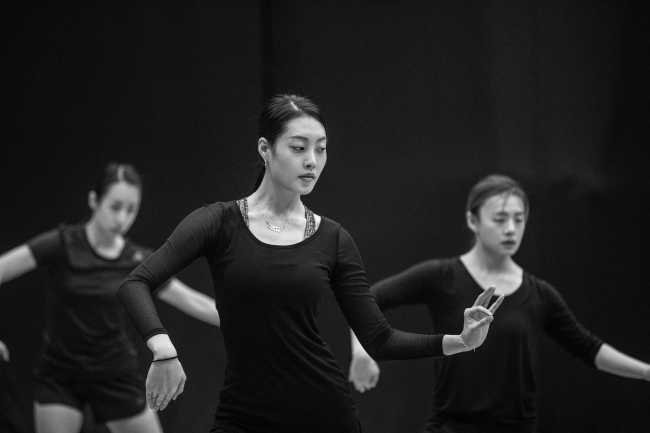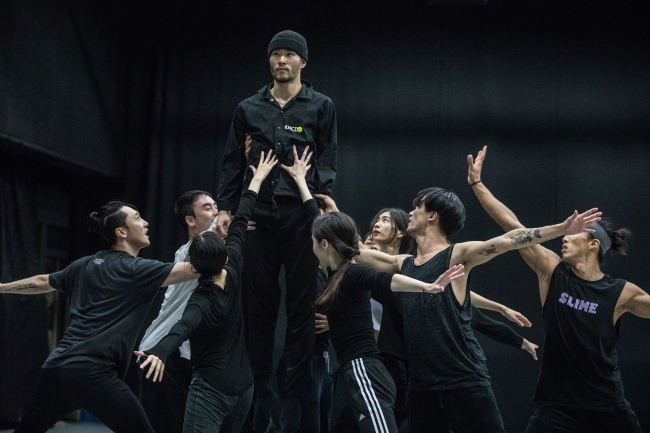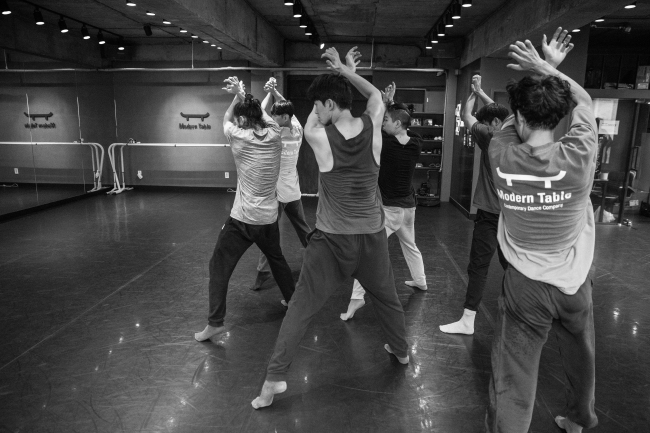The Korea National Contemporary Dance Company’s “Three Stravinsky” is a set of three dances based on three compositions by Igor Stravinsky, one of the most influential composers of the 20th century.
A follow-up project to last year’s “Three Bolero,” in which three choreographers reinterpreted composer Maurice Ravel’s “Bolero,” this piece also involved three choreographers: the company’s artistic director Ahn Sung-soo and colleagues Kim Jae-duk and Jung Young-doo. Each one selected a Stravinsky score to bring to life -- respectively, they are “The Rite of Spring,” “Agon” and “Symphony in C.”
 |
Dancers rehearse Jung Young-doo’s interpretation of Stravinsky’s “Symphony in C.” (KNCDC) |
 |
Dancers rehearse Ahn Sung-soo’s interpretation of “The Rite of Spring” (KNCDC) |
Ahn’s choreography for “The Rite of Spring,” a seminal work of modernism that breaks away from tradition, is based on his 2009 production “Rose-the Rite of Spring,” where he tweaked the narrative to make the sacrificial victim a man instead of a young woman.
If Ahn’s previous work revolved more around symbols and the narrative of the score, his latest interpretation delves deeper into the music.
Kim tackles “Agon,” a piece created in the 1950s by Stravinsky with choreographer George Balanchine on commission by the New York City Ballet. The piece is renowned for its abstractness, as well as for the absence of plot and characters.
“‘Agon’ is a very protean composition. It does not build up but changes endlessly,” Kim told The Korea Herald in a phone interview Monday.
 |
Dancers practice Kim Jae-duk’s interpretation of Stravinsky’s “Agon.” (KNCDC) |
“Agon,” Stravinsky’s atonal composition, is regarded as the composer’s first work that employed Arnold Schoenberg’s 12-tone technique -- a radical method of composition that uses all 12 notes of the chromatic scale and gives equal importance to every one. The original “Agon” consisted of 12 movements and 12 dancers.
“It was very difficult to choreograph a dance to the music (because it has no narrative, character or dominating tonality). I had to study Stravinsky to empathize with his music,” Kim said. “The choreography is largely my emotional response to the music. For that, the music takes the central role in my work. I hope my choreography, which I believe to be a visual representation of the composition, can help the audience better understand the music.”
Jung’s choreography for “Symphony in C” uses images that came to his mind as he listened to the four-movement composition. The visual images created by the dancers’ movements are designed to coalesce with the music, he added.
Korean Symphony Orchestra, under conductor Chung Chi-yong, will perform the Stravinsky pieces.
The Korea National Contemporary Dance Company’s “Three Stravinsky” runs Nov. 30 - Dec. 2 at Seoul Arts Center, CJ Towol Theater.
By Shim Woo-hyun(
ws@heraldcorp.com)









![[Today’s K-pop] Blackpink’s Jennie, Lisa invited to Coachella as solo acts](http://res.heraldm.com/phpwas/restmb_idxmake.php?idx=644&simg=/content/image/2024/11/21/20241121050099_0.jpg)
